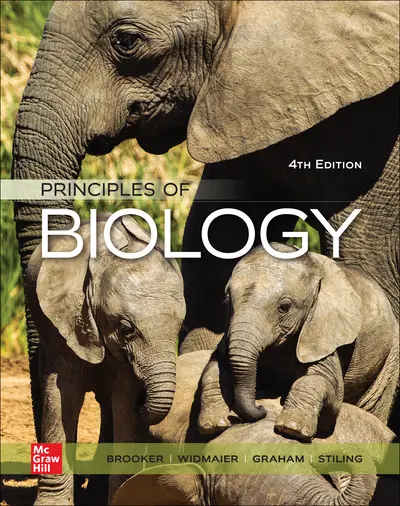My Account Details

ISBN10: 1265123659 | ISBN13: 9781265123659

* The estimated amount of time this product will be on the market is based on a number of factors, including faculty input to instructional design and the prior revision cycle and updates to academic research-which typically results in a revision cycle ranging from every two to four years for this product. Pricing subject to change at any time.
Instructor Information
Quick Actions (Only for Validated Instructor Accounts):
Principles of Biology is reflective of the shift taking place in the majors biology course from large and detail rich to short and conceptual, with a focus on new, cutting-edge science. A succinct and inviting text focused on central concepts, Principles of Biology helps students connect fundamental principles while challenging them to develop and hone critical thinking skills.
UNIT I Chemistry
2 The Chemical Basis of Life I: Atoms, Molecules, and Water
3 The Chemical Basis of Life II: Organic Molecules
UNIT II Cells
4 Evolutionary Origin of Cells and Their General Features
5 Membranes: The Interface Between Cells and Their Environment
6 How Cells Utilize Energy
7 How Cells Capture Light Energy via Photosynthesis
8 How Cells Communicate with Each Other and with the Environment
UNIT III Genetics
9 The Information of Life: DNA and RNA Structure, DNA Replication, and Chromosome Structure
10 The Expression of Genetic Information via Genes I: Transcription and Translation
11 The Expression of Genetic Information via Genes II: Non-coding RNAs
12 The Control of Genetic Information via Gene Regulation
13 Altering the Genetic Material: Mutation, DNA Repair, and Cancer
14 How Eukaryotic Cells Sort and Transmit Chromosomes: Mitosis and Meiosis
15 Transmission of Genetic Information from Parents to Offspring I: Patterns That Follow Mendel’s Laws
16 Transmission of Genetic Information from Parents to Offspring II: Epigenetics, Linkage, and Extranuclear
Inheritance
17 The Simpler Genetic Systems of Viruses, Bacteria, and Archaea
18 Genetic Technologies: How Biologists Study Genes and Genomes
UNIT IV Evolution
19 Evolution of Life I: How Populations Change from Generation to Generation
20 Evolution of Life II: The Emergence of New Species
21 How Biologists Classify Species and Study Their Evolutionary Relationships
22 The History of Life on Earth and Human Evolution
UNIT V Diversity
23 Diversity of Microbial Life: Archaea, Bacteria, Protists, and Fungi
24 Microbiomes: Microbial Systems on and Around Us
25 Plant Evolution: How Plant Diversification Changed Planet Earth
26 Invertebrates: The Vast Array of Animal Life Without a Backbone
27 Vertebrates: Fishes, Amphibians, Reptiles, and Mammals
UNIT VI Flowering Plants
28 An Introduction to Flowering Plant Form and Function
29 How Flowering Plants Sense and Interact with Their Environments
30 How Flowering Plants Obtain and Transport Water, Mineral Nutrients, and Organic Compounds
31 How Flowering Plants Reproduce and Develop
UNIT VII Animals
32 General Features of Animal Bodies, and Homeostasis as a Key Principle of Animal Biology
33 Neuroscience I: The Structure, Function, and Evolution of Nervous Systems
34 Neuroscience II: How Sensory Systems Allow Animals to Interact with the Environment
35 How Muscles and Skeletons Are Adaptations for Movement, Support, and Protection
36 Circulatory and Respiratory Systems: Transporting Solutes and Exchanging Gases
37 Digestive and Excretory Systems: Maintaining Nutrient, Water, and Energy Balance and Removing Waste
38 How Endocrine Systems Influence the Activities of All Other Organ Systems
39 The Production of Offspring: Reproduction and Development
40 Immune Systems: How Animals Defend Against Pathogens and Other Dangers
41 An Example of a System-Wide Response to a Challenge to Homeostasis
UNIT VIII Ecology
42 Behavioral Ecology: The Struggle to Find Food and Mates and to Pass on Genes
43 Population Growth and Species Interactions
44 Communities and Ecosystems: Ecological Organization at Large Scales
45 Biomes: How Climate Affects the Distribution of Species on Earth
46 The Age of Humans
47 Biodiversity and Conservation Biology
Accessibility
Creating accessible products is a priority for McGraw Hill. We make accessibility and adhering to WCAG AA guidelines a part of our day-to-day development efforts and product roadmaps.
For more information, visit our accessibility page, or contact us at accessibility@mheducation.com
Need support? We're here to help - Get real-world support and resources every step of the way.